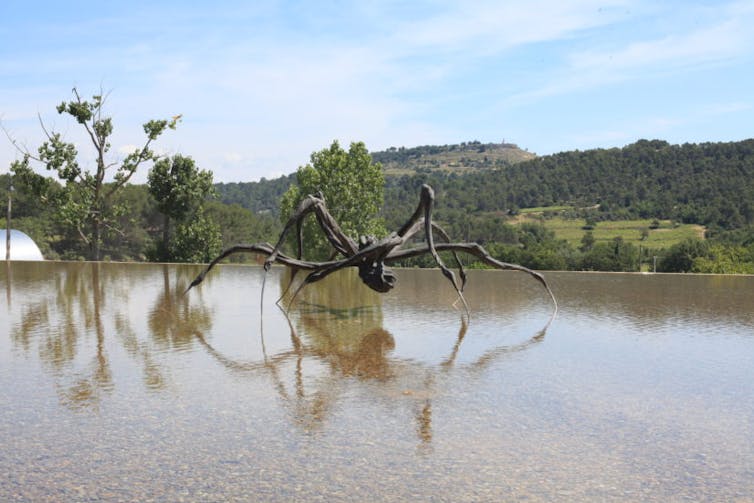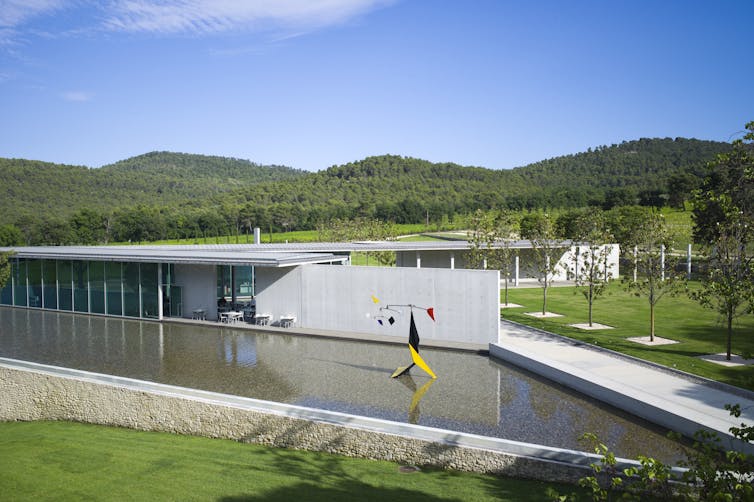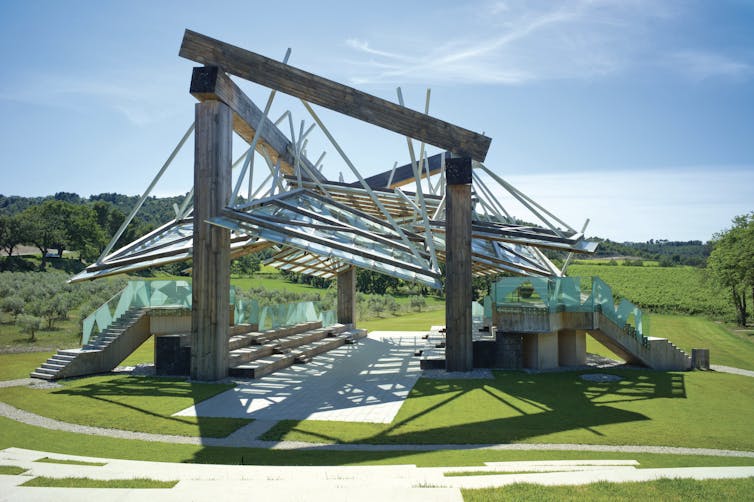If I could go anywhere: Château La Coste, a sculpture and wine walk in Provence holds random surprises
- Written by Emma Felton, Honorary Senior Research Fellow, Creative Industries Faculty, Queensland University of Technology
In this series we pay tribute to the art we wish could visit — and hope to see once travel restrictions are lifted.
As winter digs in across the country, I’ve been thinking of summer days in Europe. How pleasant to be back in sunny, southern France among the vineyards and hum of crickets, rather than trapped on our large island continent with little prospect of a return to Europe anytime soon.
One of the highlights of my visit to that region in the summer of 2017 was the surprising Château La Coste, an art and architecture park in the heart of Provence, about 15 kilometres north of the university town of Aix-en-Provence.
Surprising, partly because the 600-acre enterprise was established by one individual with no public subsidies, and an Irishman at that. Also surprising because we’d been staying with local friends for several weeks before discovering the park’s existence nearby while idly googling. Château La Coste’s most delightful surprises still awaited us.
Paddy’s place
Paddy McKillen, a publicity-shy hotelier and investor, bought the land and developed the park in 2011.
Among his site-specific acquisitions are 34 works of art, large scale sculptures, small buildings and pavilions from renown artists and architects such as Frank Gehry, Jean Nouvel and Tadao Ando.
“We looked at many, many places,” McKillen told GQ. “And then, one morning, I drove into Château La Coste. I didn’t even drive 20 metres — I decided to buy it right there, because it had a magical feel.”
A drone’s eye view of Château La Coste’s sculpture walk.Besides the art and architecture trail, the lure of La Coste is also its biodynamic vineyard, with adjacent cafe and fine dining restaurant. The winery is designed by Jean Nouvel, consisting of two striking metallic cylinders, and provides a suitably refined final stop after the leisurely two-hour trail through the park.
The vineyards spread out before us to the Luberon Hills, flanked by olive groves and lines of Judas trees.
Read more: Young female South African architect reinvents Serpentine Pavilion in London
Enter via the bookshop
We make our entrance through the sleek Tadao Ando designed building, which houses a small gallery and bookshop, and the cafe and restaurant.
Its V-shape appears to sit in a bed of water from certain angles and its low slung, concrete walls blend artfully with the grey-green hues of the landscape.
Perched in the water surrounding the building is Louise Bourgeois’s giant, menacing Crouching Spider (2007), poised to strike fear into any passing arachnophobe.
Nearby, Hiroshi Sugimoto’s Mathematical Model Surface of Revolution (2010), a gleaming cone base sculpture ascends to the heavens, thinning to needle point towards the tip. For a bit of colourful whimsy, Alexander Calder’s Small Crinkly (1976) completes the trio of water-based sculptures.
 Louise Bourgeois Crouching Spider. The Easton Foundation ADAGP Paris.
Author provided, Author provided
Louise Bourgeois Crouching Spider. The Easton Foundation ADAGP Paris.
Author provided, Author provided
Read more: If I could go anywhere: I'd revisit Maman, Louise Bourgeois' 9-metre spider at London's Tate Modern
Wandering from the building out through the vineyards towards the hills, the art trail meanders across grassland and rocky terrain and occasionally under the canopy of large forest trees. Tom Shannon’s Drop (2009) seems to hover like a silver spaceship above the vines.
It is here we find the remarkable Oak Room by British sculptor Andy Goldsworthy. The visitor descends into a small, cave-like structure, whose entire curved walls and ceiling are constructed from plaited tree branches, creating a comforting and peaceful ambience. The woody odour is appealing too, reminiscent of a vineyard’s barrel room.
By contrast, out in the sunlight the multi-coloured Multiplied Resistence Screened (2010) by Liam Gillick, invites interactivity and play by moving colourful panels of barred walls and creating different shapes and spaces.
Irish-American artist Sean Scully, who made his reputation as an abstract painter, departs here with two sculptural pieces. His Wall of Light Cubed (2007), a composite wall of pink and grey geometric volcanic stone blocks, is faced across an olive grove by his Boxes Full of Air (2015), a monument of stacked rectangular frames made in corten (rusted) steel.
 Tadao Ando Art Centre.
Château La Coste/Photo: Andrew Pattman
Tadao Ando Art Centre.
Château La Coste/Photo: Andrew Pattman
Read more: It seemed like a good idea in lockdown, but is moving to the country right for you?
Happy wandering
It’s a joyful experience to wander through the landscape in the waning days of summer, “discovering” works of art as they seemingly appear at random throughout the estate. But of course, their placement is not random. Owner McKillen doesn’t like the phrase “sculpture park” but notes there is a “science to where the pieces are located”.
There are so many notable works, created by so many renown artists, it is difficult to single any out. Tracey Emin, Tunga, Sophie Calle, Guggi, Richard Serra, Tom Shannon, Jenny Holzer and Paul Matisse (yes, grandson of Henri) to name a few. Even former REM singer Michael Stipe is represented (Fox, 2008).
Two structures stand out.
One is the tiny chapel designed by Tadao Ando, whose elegant interior invites contemplation and feels somehow connected to the natural world outside with its rough sandstone walls and glass portico. A large red cross made of glass beads (Jean-Michel Othoniel 2008) dominates the courtyard behind the chapel.
And of course, Frank Gehry’s Music Pavilion provides a focal point of the estate, with its striking deconstructed roof and off kilter angles that is Gehry’s signature.
 Frank O. Gehry’s Pavillon de Musique.
Château La Coste/Photograph: Andrew Pattman
Frank O. Gehry’s Pavillon de Musique.
Château La Coste/Photograph: Andrew Pattman
Read more: If I could go anywhere: Marie Antoinette's private boudoir and mechanical mirror room at Versailles
Château La Coste is one of the earliest examples of what’s now known as “oenotourism”, a growth industry where wineries in or close to tourist areas also house and exhibit contemporary art. The exhibitions are usually temporary but La Coste is an exception.
Most acquisitions will be added to their permanent collection over the next few years, reportedly including an installation by artist Olafur Eliasson. Architect Richard Rogers just completed a cantilevered pavilion jutting out from the hillside. The property has 28 villa suites for a longer stay. Another reason to get on a plane as soon as travel restrictions are lifted.
Authors: Emma Felton, Honorary Senior Research Fellow, Creative Industries Faculty, Queensland University of Technology





